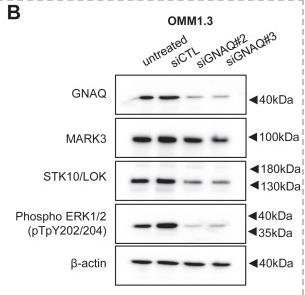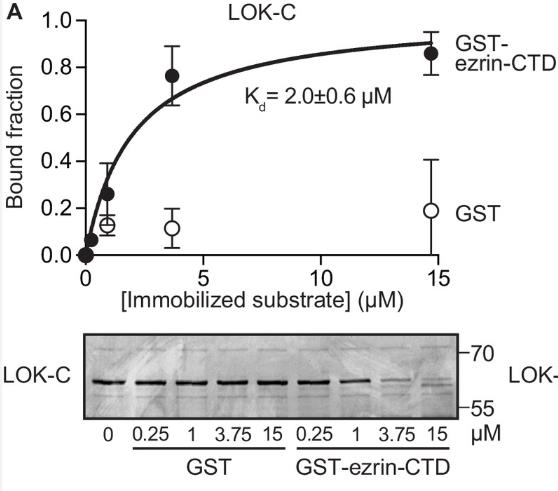STK10
-
Official Full Name
serine/threonine kinase 10 -
Overview
This gene encodes a member of the Ste20 family of serine/threonine protein kinases, and is similar to several known polo-like kinase kinases. The protein can associate with and phosphorylate polo-like kinase 1, and overexpression of a kinase-dead version of the protein interferes with normal cell cycle progression. The kinase can also negatively regulate interleukin 2 expression in T-cells via the mitogen activated protein kinase kinase 1 pathway. -
Synonyms
STK10;serine/threonine kinase 10;serine/threonine-protein kinase 10;LOK;PRO2729;lymphocyte-oriented kinase
Recombinant Proteins
- Human
- Zebrafish
- Mouse
- E.coli
- Mammalian Cell
- Sf9 Insect Cell
- Insect Cell
- HEK293
- HEK293T
- Insect (sf21)
- His
- GST
- Non
- Myc&DDK
| Cat.# | Product name | Source (Host) | Species | Tag | Protein Length | Price |
|---|---|---|---|---|---|---|
| STK10-765H |
Active Recombinant Human STK10, His tagged
|
E.coli | Human | His | Arg 18-Glu 317 | |
| STK10-11354Z | Recombinant Zebrafish STK10 | Mammalian Cell | Zebrafish | His |
|
|
| STK10-343H | Recombinant Human Serine/Threonine Kinase 10, GST-tagged, Active | Sf9 Insect Cell | Human | GST | 1-348 a.a. |
|
| STK10-555H | Recombinant Human Serine/Threonine Kinase 10, His-tagged | Sf9 Insect Cell | Human | GST |
|
|
| STK10-1711HCL | Recombinant Human STK10 cell lysate | Human | Non |
|
||
| STK10-1120H | Recombinant Human STK10 Protein (M1-S348), Tag Free | Insect Cell | Human | Non | M1-S348 |
|
| STK10-1121H | Recombinant Human STK10 Protein (M1-S348), GST tagged | Insect Cell | Human | GST | M1-S348 |
|
| STK10-2966H | Recombinant Human STK10 Protein, MYC/DDK-tagged | HEK293 | Human | Myc&DDK |
|
|
| Stk10-6181M | Recombinant Mouse Stk10 Protein, Myc/DDK-tagged | HEK293T | Mouse | Myc&DDK |
|
|
| STK10-9744HF | Active Recombinant Full Length Human STK10 Protein, GST-tagged | Insect (sf21) | Human | GST | Full L. 1-968(end) |
|
Background
What is STK10 protein?
STK10 gene (serine/threonine kinase 10) is a protein coding gene which situated on the long arm of chromosome 5 at locus 5q35. This gene encodes a member of the Ste20 family of serine/threonine protein kinases, and is similar to several known polo-like kinase kinases. The protein can associate with and phosphorylate polo-like kinase 1, and overexpression of a kinase-dead version of the protein interferes with normal cell cycle progression. The kinase can also negatively regulate interleukin 2 expression in T-cells via the mitogen activated protein kinase kinase 1 pathway. The STK10 protein is consisted of 968 amino acids and STK10 molecular weight is approximately 112.1 kDa.
What is the function of STK10 protein?
STK10 protein is a serine/threonine kinase that plays a role in the regulation of lymphocyte migration and activation. It is involved in the phosphorylation of proteins such as moesin (MSN) and possibly PLK1, and it mediates the phosphorylation of ezrin-radixin-moesin (ERM) proteins, which are crucial for cell shape changes, adhesion, and migration. STK10 has been implicated in the development and metastasis of various types of cancer, including prostate cancer, by affecting cell proliferation and migration. Additionally, STK10 has been identified as a potential prognostic marker and therapeutic target in acute myeloid leukemia (AML), where it is associated with poor overall survival and influences immune function and biological processes of AML.
STK10 related signaling pathway
The STK10-related signaling pathway is a complex network that plays a crucial role in various cellular processes, including cell cycle regulation, apoptosis, and response to oxidative stress. STK10, also known as serine/threonine kinase 10, is a component of the Hippo pathway, which is involved in controlling organ size, stem cell proliferation, and tumor suppression. Through its interactions with other pathway components such as MST1/2 (mammalian sterile 20-like kinases) and LATS1/2 (large tumor suppressor kinases), STK10 helps regulate the activity of transcriptional coactivators like YAP (Yes-associated protein) and TAZ (transcriptional coactivator with PDZ-binding motif). Dysregulation of this pathway can lead to uncontrolled cell growth and is implicated in the development of cancers. Understanding the intricacies of the STK10-mediated signaling cascade is essential for identifying novel therapeutic targets and strategies against related diseases.
STK10 related diseases
STK10 protein, also known as LOK, is involved in the development and progression of several diseases, most notably acute myeloid leukemia (AML). High expression levels of STK10 are associated with poor overall survival in AML patients, and it may serve as a new prognostic marker or therapeutic target for this disease. Additionally, STK10 plays a role in the immune response and cell migration, impacting the tumor microenvironment in cancer progression.
Bioapplications of STK10
The bioapplications of STK10 are primarily focused on its role in cancer biology and therapeutic interventions. As a component of the Hippo signaling pathway, STK10 is involved in regulating cell proliferation, apoptosis, and organ size control, making it a potential target for developing novel anti-cancer therapies. Strategies to modulate STK10 activity or expression hold promise for treating various types of cancers where this pathway is dysregulated. Additionally, understanding the mechanisms through which STK10 influences cellular processes can contribute to the development of personalized medicine approaches, enhancing treatment efficacy and minimizing side effects for patients with cancer and other related diseases.
Case Study
Case Study 1: Usman Baqai, 2023
Uveal melanoma often has mutations in GNAQ or GNA11, activating the MAPK pathway, but no targeted therapies exist for its metastatic form. The human kinome's unexplored kinases might hold new targets. Using a Gαq/11 inhibitor on mutant cell lines, researchers identified 22 downregulated kinases. Knocking down MARK3 and STK10 reduced cell growth and cell cycle protein expression, with MARK3 also affecting ERK1/2 phosphorylation. Data indicate Gαq signaling's role in regulating STK10 and MARK3, suggesting their involvement in Gαq/11 pathway and potential as therapeutic targets for uveal melanoma.

Fig1. Publicly available RNA-seq data was analyzed for MARK3 and STK10 expression following 24-h YM-254890 treatment in Mel202 and OMM1.3 cells.

Fig2. Representative Western blots showing the effect of siGNAQ on MARK3 and STK10 expression.
Case Study 2: Thaher Pelaseyed, 2017
The process by which cells establish distinct plasma membrane domains is not well understood. This study reveals a multi-step mechanism where the kinase LOK phosphorylates ezrin to activate it, which is essential for microvilli restriction in epithelial cells. LOK's C-terminal domain separates ezrin's membrane and F-actin-binding domains after a conformational change induced by PIP2 binding, allowing the kinase domain to phosphorylate a specific threonine residue. This mechanism ensures ezrin phosphorylation occurs only at the plasma membrane by the apically localized LOK, with high specificity.

Fig3. 10 nM LOK and 10 nM LOK-N phosphorylate 18 μM GST-ezrin-CTD, but both LOK and LOK-N fail to phosphorylate 18 μM of a GST-ezrin-CTD+FERM complex in absence or presence of 90 μM PIP2.

Fig4. A binding curve for binding of 0–15 μM immobilized GST-ezrin-CTD to 200 nM LOK-C at Kd = 2.0 ± 0.6 μM.
Quality Guarantee
Involved Pathway
STK10 involved in several pathways and played different roles in them. We selected most pathways STK10 participated on our site, such as , which may be useful for your reference. Also, other proteins which involved in the same pathway with STK10 were listed below. Creative BioMart supplied nearly all the proteins listed, you can search them on our site.
| Pathway Name | Pathway Related Protein |
|---|
Protein Function
STK10 has several biochemical functions, for example, ATP binding,identical protein binding,polo kinase kinase activity. Some of the functions are cooperated with other proteins, some of the functions could acted by STK10 itself. We selected most functions STK10 had, and list some proteins which have the same functions with STK10. You can find most of the proteins on our site.
| Function | Related Protein |
|---|---|
| identical protein binding | SFRP1,BNIPL,TRAF6,BRAP,DNM1,GCC2,MICU1,GPSM2,DNM1L,HAPLN2 |
| protein homodimerization activity | MAP3K9,FZD1,GTF2A2,PAFAH1B2,HNF4A,CECR1,CTBP2,UGT1A6A,MYH9,PFKM |
| protein serine/threonine kinase activity | BRAF,ILK,CAMK1DB,STK3,SNRK,MAP3K9,PRKACBA,PRKD2,WNK1,NEK2 |
| protein binding | CDCP1,ANK2,TMEM30A,FAM19A4,HSP90AA1.1,BBC3,RIPK3,EIF2AK3,HTR1B,DOLK |
| ATP binding | MERTK,PTK2,EHD4,ABCA4A,HYOU1,RRM1,PAK6,GALK1,CSNK1G1,GM711 |
Interacting Protein
STK10 has direct interactions with proteins and molecules. Those interactions were detected by several methods such as yeast two hybrid, co-IP, pull-down and so on. We selected proteins and molecules interacted with STK10 here. Most of them are supplied by our site. Hope this information will be useful for your research of STK10.
abl-tide;midostaurin
Resources
Related Services
Related Products
References

.jpg)
.jpg)

